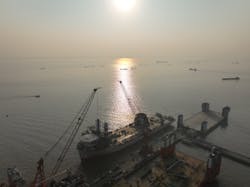Jan De Nul heavy lift vessel launched in China
Offshore staff
LUXEMBOURG – Jan De Nul has launched its installation vessel Les Alizés at the CMHI Haimen shipyard in China.
The launch started on Jan. 2 by flooding the drydock in which the vessel was built. Once afloat, the Les Alizés was moored alongside the adjacent quay wall.
The final phase of construction will now begin, including sea trials. The Les Alizés is expected to be delivered in H2 2022.
This will be the largest heavy lift vessel in the company’s fleet. It is expected to be able to install XXL offshore wind components.
The vessel’s first assignment is to transport and install 107 monopile foundations for Ørsted’s Gode Wind 3 and Borkum Riffgrund 3 offshore wind farms in the German North Sea.
According to Jan De Nul, the Les Alizés will feature equipment that improve safety and efficiency in offshore wind installations.
For instance, Huisman has developed a Universal Quick Connector, a clamp that is mounted inside the crane’s lower block. It attaches and detaches loads and tools directly to the crane’s lower block without rigging.
A motion-compensated pile gripper, with an integrated guidance and survey system, will allow safe and efficient installation of next-generation monopiles with pin-point accuracy.
Also, a fully automated monopile handling system that consists of a set of cradles, a skidding system and an upending hinge will handle and install XXL monopiles. It is said to be ideally suited to work in challenging weather conditions and high sea states.
Finally, the Les Alizés will be an ultra-low emission vessel with hybrid capability. To reduce the vessel’s CO2 emissions, the power plant on board is a hybrid setup. The arrangement combines diesel-driven generators with battery and drive technology to optimize engine loading and to recover the potential energy returned from the heavy lift crane. The vessel can run on second-generation biodiesel that reduces the fuel carbon footprint by up to 90%, the company said.
It is equipped with a dual exhaust filter system, removing up to 99% of nanoparticles from emissions using a diesel particulate filter and reducing the NOx emissions and other pollutants with a selective catalytic reduction system to levels in accordance with EU Stage V regulation.
01/06/2022
